An Innovative Business Case for Trunki: Commercialisation Strategies
VerifiedAdded on 2023/01/18
|10
|3266
|88
Report
AI Summary
This report presents a detailed analysis of Trunki's business case, focusing on innovation and commercialization strategies. The introduction defines innovation and its importance compared to invention, highlighting organizational vision, leadership, culture, and teamwork's impact on innovation. The report then explores different types of innovation, including the 4Ps of innovation (product, process, position, and paradigm) and the use of the innovation funnel. Frugal innovation and its applications within an organizational context are also discussed. The core of the report examines the commercialization process, including the importance of the commercial funnel and the application of the new product development (NPD) process. A specific innovation business case for Trunki is presented, including methods for accessing funding. Finally, the report evaluates various tools organizations can use to develop, retain, and protect knowledge and intellectual property, concluding with a summary of the findings and supporting references.
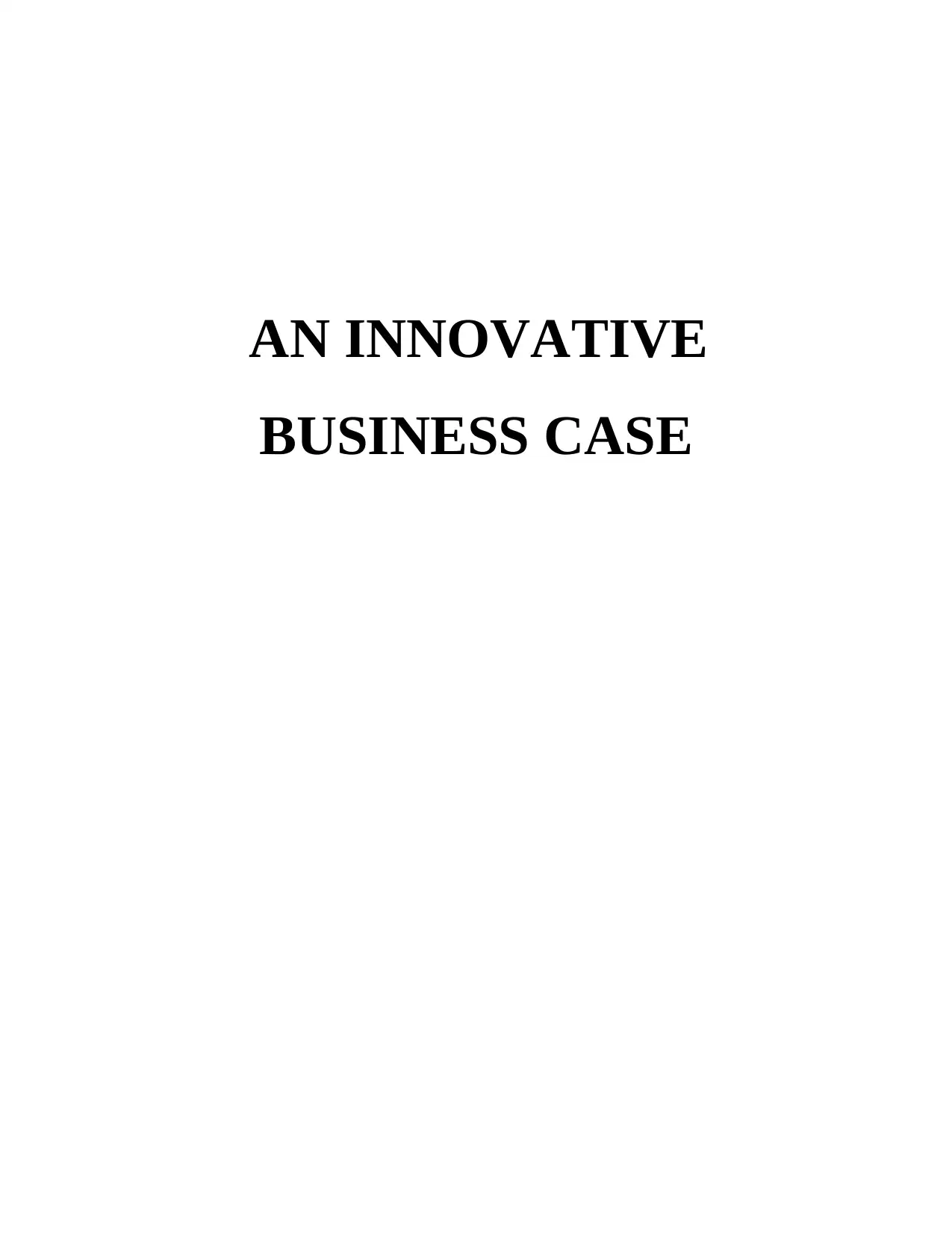
AN INNOVATIVE
BUSINESS CASE
BUSINESS CASE
Paraphrase This Document
Need a fresh take? Get an instant paraphrase of this document with our AI Paraphraser
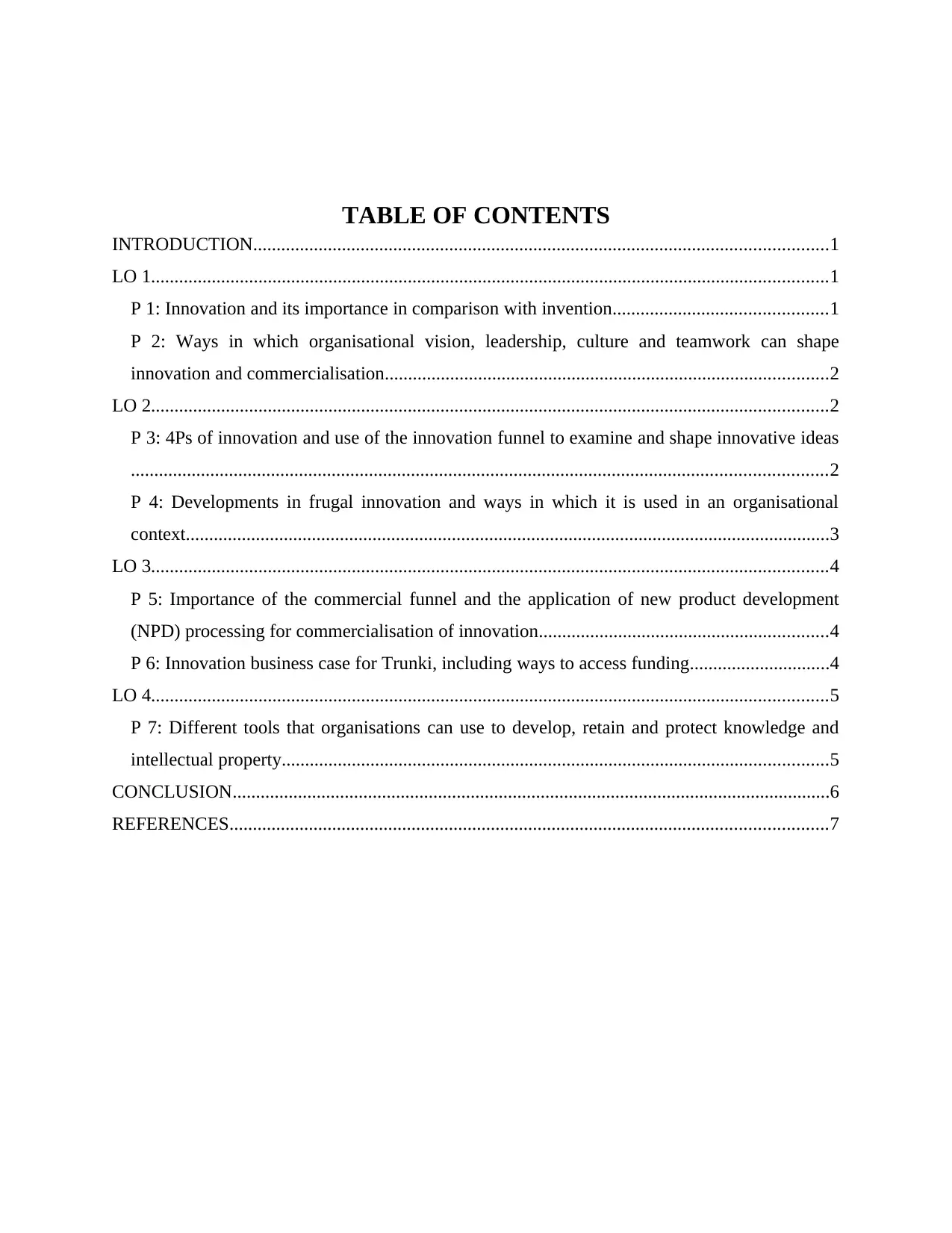
TABLE OF CONTENTS
INTRODUCTION...........................................................................................................................1
LO 1.................................................................................................................................................1
P 1: Innovation and its importance in comparison with invention..............................................1
P 2: Ways in which organisational vision, leadership, culture and teamwork can shape
innovation and commercialisation...............................................................................................2
LO 2.................................................................................................................................................2
P 3: 4Ps of innovation and use of the innovation funnel to examine and shape innovative ideas
.....................................................................................................................................................2
P 4: Developments in frugal innovation and ways in which it is used in an organisational
context..........................................................................................................................................3
LO 3.................................................................................................................................................4
P 5: Importance of the commercial funnel and the application of new product development
(NPD) processing for commercialisation of innovation..............................................................4
P 6: Innovation business case for Trunki, including ways to access funding..............................4
LO 4.................................................................................................................................................5
P 7: Different tools that organisations can use to develop, retain and protect knowledge and
intellectual property.....................................................................................................................5
CONCLUSION................................................................................................................................6
REFERENCES................................................................................................................................7
INTRODUCTION...........................................................................................................................1
LO 1.................................................................................................................................................1
P 1: Innovation and its importance in comparison with invention..............................................1
P 2: Ways in which organisational vision, leadership, culture and teamwork can shape
innovation and commercialisation...............................................................................................2
LO 2.................................................................................................................................................2
P 3: 4Ps of innovation and use of the innovation funnel to examine and shape innovative ideas
.....................................................................................................................................................2
P 4: Developments in frugal innovation and ways in which it is used in an organisational
context..........................................................................................................................................3
LO 3.................................................................................................................................................4
P 5: Importance of the commercial funnel and the application of new product development
(NPD) processing for commercialisation of innovation..............................................................4
P 6: Innovation business case for Trunki, including ways to access funding..............................4
LO 4.................................................................................................................................................5
P 7: Different tools that organisations can use to develop, retain and protect knowledge and
intellectual property.....................................................................................................................5
CONCLUSION................................................................................................................................6
REFERENCES................................................................................................................................7

INTRODUCTION
Innovation is one of the most important thing that an organization should focus on as it helps
the organization to grow. In order to bring innovation within n organization innovation manager
need to think of various ideas for innovative development of product and its commercialization
(Amabile and Pratt, 2016). This assignment will lay emphasis on concept of innovation, different
types of innovation, process required to commercialise innovation and methods for protecting
ideas and understand their advantages and disadvantages.
LO 1
P 1: Innovation and its importance in comparison with invention
Innovation can be defined as a procedure of converting an idea or concept into a new
product or service. The main aim or objecting on the basis of which innovation is done is that it
should be liked and valued by people and they should be ready to pay for it. An organization
need to think and develop new ideas in such a manner that, that idea can be replicated in reality
in an economical cost such that need of their customer’s is also satisfied. An organization needs
to think of various things before developing an innovative idea in reality such as: whether
customer’s need will be satisfied, ways in which it will be created, ways in which relevant
information will be gathered, resources that will be required by the organization and applications
that will be required to be complied together. There are mainly two types of innovations. When
positive changes or advancements are brought together it is known as evolutionary innovation.
When Discontinuous innovations that can be disruptive sometimes but a huge success are known
as revolutionary innovation. So, it can be said that innovation is all about thinking and
developing a new idea. Trunki is a brand which is mainly known for their hand luggage’s
specifically designed for children. Main target of Trunki is children. They innovated ride on
suitcases or luggage’s for children. But after suffering a loss for back to back 2 years they
invented another type of ride on suitcase for children. Innovation is one of the most important
thing an organization should focus on as it leads an organization towards various kinds of
opportunities.
Innovation helps in maintaining creative development whereas invention helps in
professional development.
In order to become an innovative organization they need to focus on continuous development
whereas for invention they need to simply build a network and stay inspired and motivated.
1
Innovation is one of the most important thing that an organization should focus on as it helps
the organization to grow. In order to bring innovation within n organization innovation manager
need to think of various ideas for innovative development of product and its commercialization
(Amabile and Pratt, 2016). This assignment will lay emphasis on concept of innovation, different
types of innovation, process required to commercialise innovation and methods for protecting
ideas and understand their advantages and disadvantages.
LO 1
P 1: Innovation and its importance in comparison with invention
Innovation can be defined as a procedure of converting an idea or concept into a new
product or service. The main aim or objecting on the basis of which innovation is done is that it
should be liked and valued by people and they should be ready to pay for it. An organization
need to think and develop new ideas in such a manner that, that idea can be replicated in reality
in an economical cost such that need of their customer’s is also satisfied. An organization needs
to think of various things before developing an innovative idea in reality such as: whether
customer’s need will be satisfied, ways in which it will be created, ways in which relevant
information will be gathered, resources that will be required by the organization and applications
that will be required to be complied together. There are mainly two types of innovations. When
positive changes or advancements are brought together it is known as evolutionary innovation.
When Discontinuous innovations that can be disruptive sometimes but a huge success are known
as revolutionary innovation. So, it can be said that innovation is all about thinking and
developing a new idea. Trunki is a brand which is mainly known for their hand luggage’s
specifically designed for children. Main target of Trunki is children. They innovated ride on
suitcases or luggage’s for children. But after suffering a loss for back to back 2 years they
invented another type of ride on suitcase for children. Innovation is one of the most important
thing an organization should focus on as it leads an organization towards various kinds of
opportunities.
Innovation helps in maintaining creative development whereas invention helps in
professional development.
In order to become an innovative organization they need to focus on continuous development
whereas for invention they need to simply build a network and stay inspired and motivated.
1
⊘ This is a preview!⊘
Do you want full access?
Subscribe today to unlock all pages.

Trusted by 1+ million students worldwide
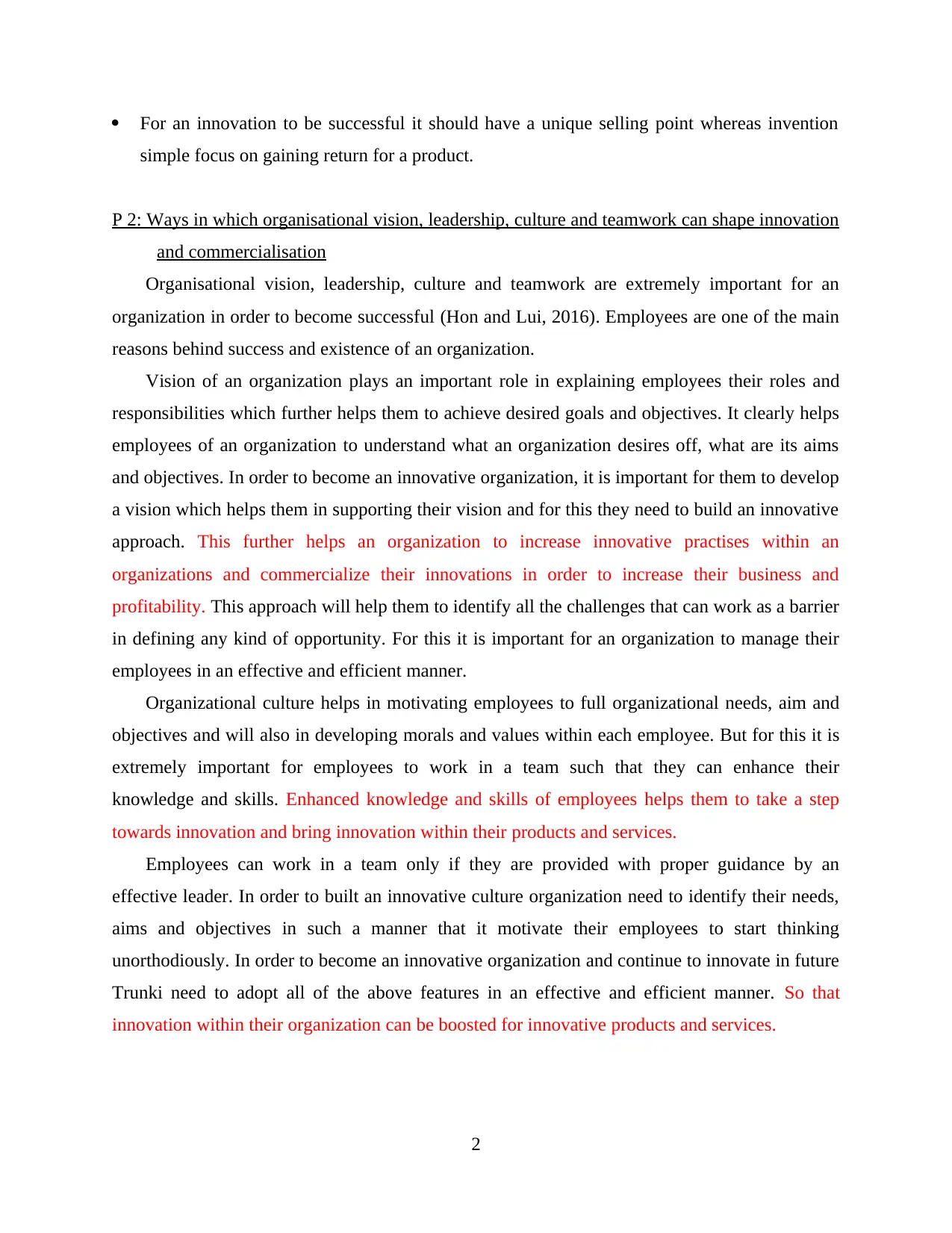
For an innovation to be successful it should have a unique selling point whereas invention
simple focus on gaining return for a product.
P 2: Ways in which organisational vision, leadership, culture and teamwork can shape innovation
and commercialisation
Organisational vision, leadership, culture and teamwork are extremely important for an
organization in order to become successful (Hon and Lui, 2016). Employees are one of the main
reasons behind success and existence of an organization.
Vision of an organization plays an important role in explaining employees their roles and
responsibilities which further helps them to achieve desired goals and objectives. It clearly helps
employees of an organization to understand what an organization desires off, what are its aims
and objectives. In order to become an innovative organization, it is important for them to develop
a vision which helps them in supporting their vision and for this they need to build an innovative
approach. This further helps an organization to increase innovative practises within an
organizations and commercialize their innovations in order to increase their business and
profitability. This approach will help them to identify all the challenges that can work as a barrier
in defining any kind of opportunity. For this it is important for an organization to manage their
employees in an effective and efficient manner.
Organizational culture helps in motivating employees to full organizational needs, aim and
objectives and will also in developing morals and values within each employee. But for this it is
extremely important for employees to work in a team such that they can enhance their
knowledge and skills. Enhanced knowledge and skills of employees helps them to take a step
towards innovation and bring innovation within their products and services.
Employees can work in a team only if they are provided with proper guidance by an
effective leader. In order to built an innovative culture organization need to identify their needs,
aims and objectives in such a manner that it motivate their employees to start thinking
unorthodiously. In order to become an innovative organization and continue to innovate in future
Trunki need to adopt all of the above features in an effective and efficient manner. So that
innovation within their organization can be boosted for innovative products and services.
2
simple focus on gaining return for a product.
P 2: Ways in which organisational vision, leadership, culture and teamwork can shape innovation
and commercialisation
Organisational vision, leadership, culture and teamwork are extremely important for an
organization in order to become successful (Hon and Lui, 2016). Employees are one of the main
reasons behind success and existence of an organization.
Vision of an organization plays an important role in explaining employees their roles and
responsibilities which further helps them to achieve desired goals and objectives. It clearly helps
employees of an organization to understand what an organization desires off, what are its aims
and objectives. In order to become an innovative organization, it is important for them to develop
a vision which helps them in supporting their vision and for this they need to build an innovative
approach. This further helps an organization to increase innovative practises within an
organizations and commercialize their innovations in order to increase their business and
profitability. This approach will help them to identify all the challenges that can work as a barrier
in defining any kind of opportunity. For this it is important for an organization to manage their
employees in an effective and efficient manner.
Organizational culture helps in motivating employees to full organizational needs, aim and
objectives and will also in developing morals and values within each employee. But for this it is
extremely important for employees to work in a team such that they can enhance their
knowledge and skills. Enhanced knowledge and skills of employees helps them to take a step
towards innovation and bring innovation within their products and services.
Employees can work in a team only if they are provided with proper guidance by an
effective leader. In order to built an innovative culture organization need to identify their needs,
aims and objectives in such a manner that it motivate their employees to start thinking
unorthodiously. In order to become an innovative organization and continue to innovate in future
Trunki need to adopt all of the above features in an effective and efficient manner. So that
innovation within their organization can be boosted for innovative products and services.
2
Paraphrase This Document
Need a fresh take? Get an instant paraphrase of this document with our AI Paraphraser
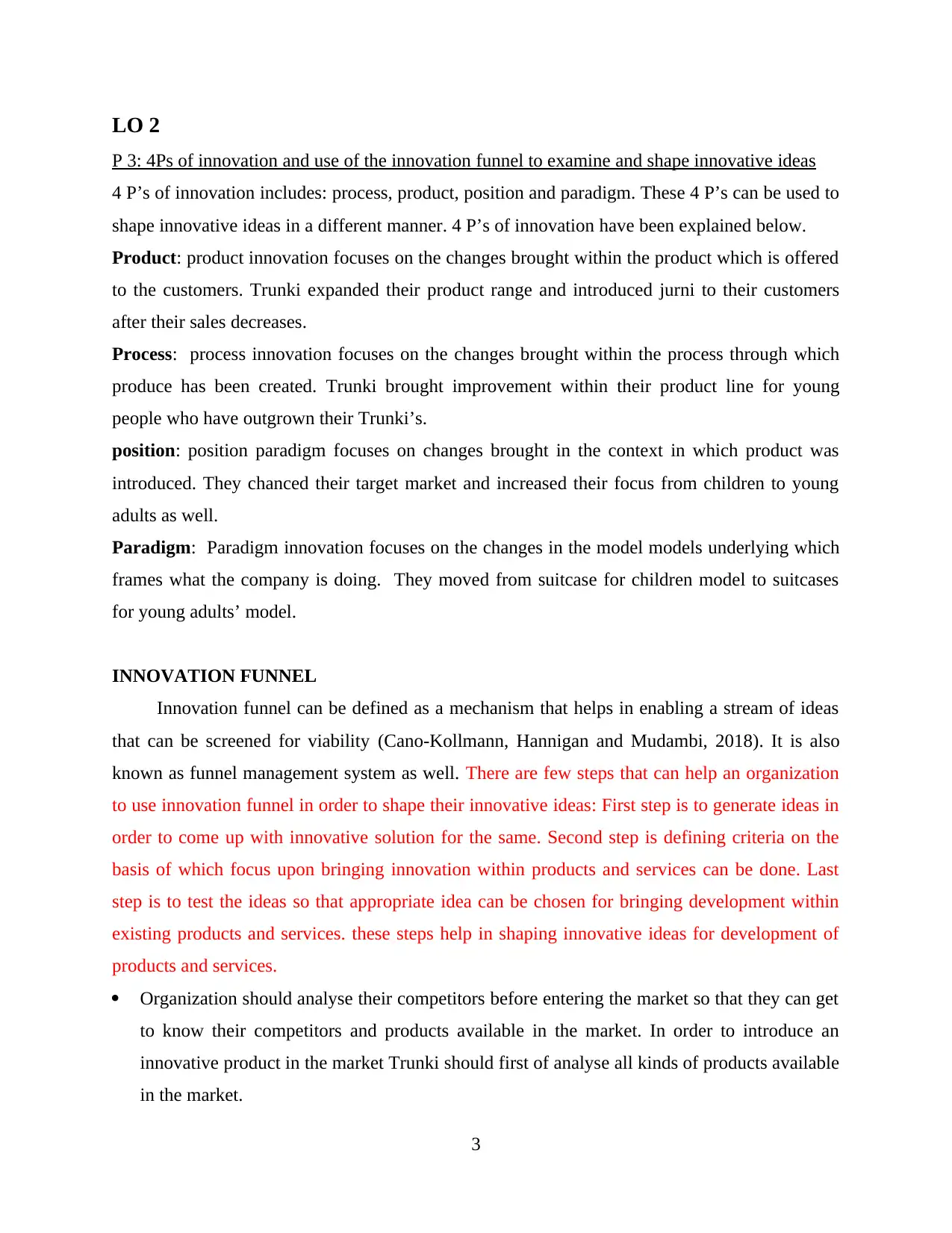
LO 2
P 3: 4Ps of innovation and use of the innovation funnel to examine and shape innovative ideas
4 P’s of innovation includes: process, product, position and paradigm. These 4 P’s can be used to
shape innovative ideas in a different manner. 4 P’s of innovation have been explained below.
Product: product innovation focuses on the changes brought within the product which is offered
to the customers. Trunki expanded their product range and introduced jurni to their customers
after their sales decreases.
Process: process innovation focuses on the changes brought within the process through which
produce has been created. Trunki brought improvement within their product line for young
people who have outgrown their Trunki’s.
position: position paradigm focuses on changes brought in the context in which product was
introduced. They chanced their target market and increased their focus from children to young
adults as well.
Paradigm: Paradigm innovation focuses on the changes in the model models underlying which
frames what the company is doing. They moved from suitcase for children model to suitcases
for young adults’ model.
INNOVATION FUNNEL
Innovation funnel can be defined as a mechanism that helps in enabling a stream of ideas
that can be screened for viability (Cano-Kollmann, Hannigan and Mudambi, 2018). It is also
known as funnel management system as well. There are few steps that can help an organization
to use innovation funnel in order to shape their innovative ideas: First step is to generate ideas in
order to come up with innovative solution for the same. Second step is defining criteria on the
basis of which focus upon bringing innovation within products and services can be done. Last
step is to test the ideas so that appropriate idea can be chosen for bringing development within
existing products and services. these steps help in shaping innovative ideas for development of
products and services.
Organization should analyse their competitors before entering the market so that they can get
to know their competitors and products available in the market. In order to introduce an
innovative product in the market Trunki should first of analyse all kinds of products available
in the market.
3
P 3: 4Ps of innovation and use of the innovation funnel to examine and shape innovative ideas
4 P’s of innovation includes: process, product, position and paradigm. These 4 P’s can be used to
shape innovative ideas in a different manner. 4 P’s of innovation have been explained below.
Product: product innovation focuses on the changes brought within the product which is offered
to the customers. Trunki expanded their product range and introduced jurni to their customers
after their sales decreases.
Process: process innovation focuses on the changes brought within the process through which
produce has been created. Trunki brought improvement within their product line for young
people who have outgrown their Trunki’s.
position: position paradigm focuses on changes brought in the context in which product was
introduced. They chanced their target market and increased their focus from children to young
adults as well.
Paradigm: Paradigm innovation focuses on the changes in the model models underlying which
frames what the company is doing. They moved from suitcase for children model to suitcases
for young adults’ model.
INNOVATION FUNNEL
Innovation funnel can be defined as a mechanism that helps in enabling a stream of ideas
that can be screened for viability (Cano-Kollmann, Hannigan and Mudambi, 2018). It is also
known as funnel management system as well. There are few steps that can help an organization
to use innovation funnel in order to shape their innovative ideas: First step is to generate ideas in
order to come up with innovative solution for the same. Second step is defining criteria on the
basis of which focus upon bringing innovation within products and services can be done. Last
step is to test the ideas so that appropriate idea can be chosen for bringing development within
existing products and services. these steps help in shaping innovative ideas for development of
products and services.
Organization should analyse their competitors before entering the market so that they can get
to know their competitors and products available in the market. In order to introduce an
innovative product in the market Trunki should first of analyse all kinds of products available
in the market.
3
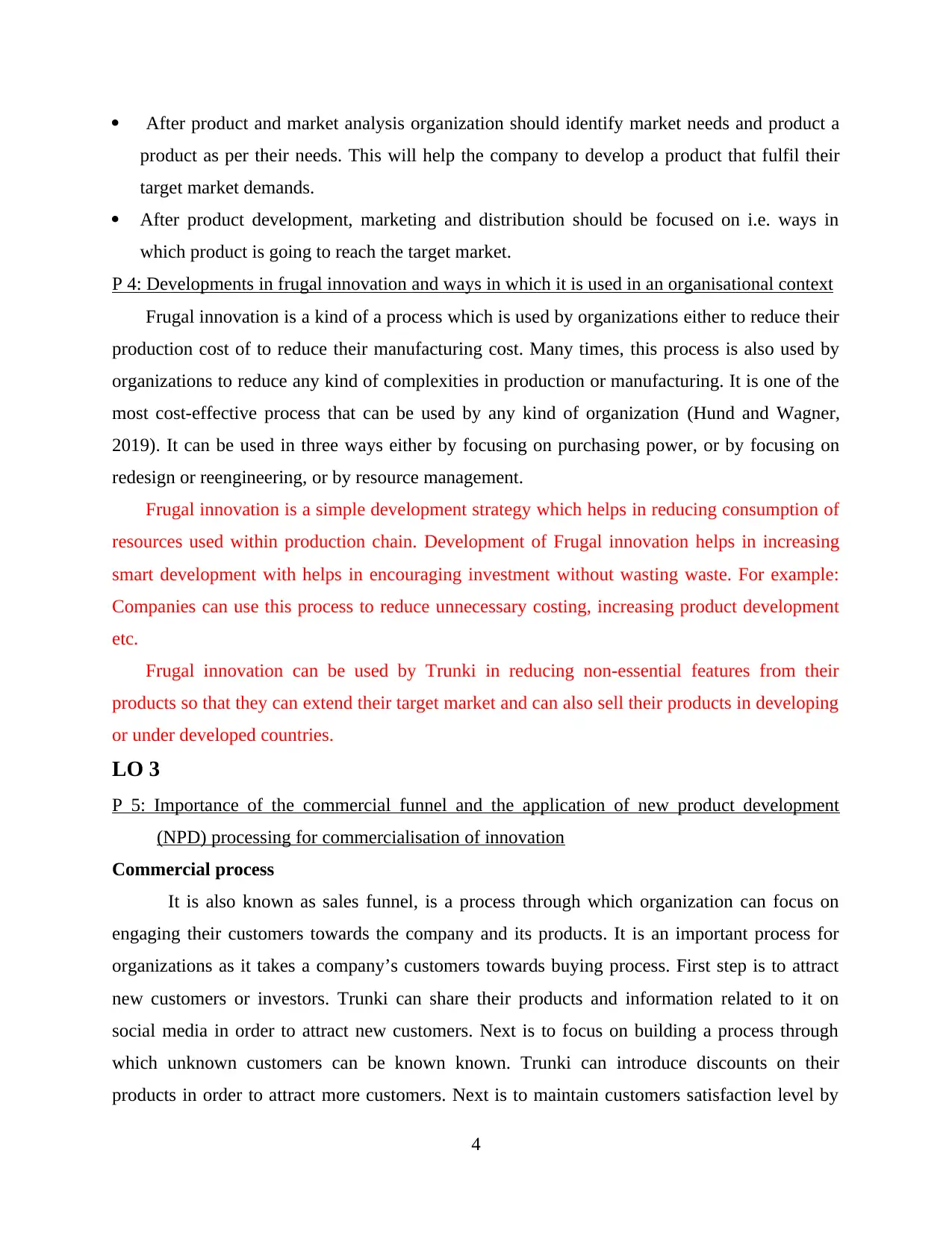
After product and market analysis organization should identify market needs and product a
product as per their needs. This will help the company to develop a product that fulfil their
target market demands.
After product development, marketing and distribution should be focused on i.e. ways in
which product is going to reach the target market.
P 4: Developments in frugal innovation and ways in which it is used in an organisational context
Frugal innovation is a kind of a process which is used by organizations either to reduce their
production cost of to reduce their manufacturing cost. Many times, this process is also used by
organizations to reduce any kind of complexities in production or manufacturing. It is one of the
most cost-effective process that can be used by any kind of organization (Hund and Wagner,
2019). It can be used in three ways either by focusing on purchasing power, or by focusing on
redesign or reengineering, or by resource management.
Frugal innovation is a simple development strategy which helps in reducing consumption of
resources used within production chain. Development of Frugal innovation helps in increasing
smart development with helps in encouraging investment without wasting waste. For example:
Companies can use this process to reduce unnecessary costing, increasing product development
etc.
Frugal innovation can be used by Trunki in reducing non-essential features from their
products so that they can extend their target market and can also sell their products in developing
or under developed countries.
LO 3
P 5: Importance of the commercial funnel and the application of new product development
(NPD) processing for commercialisation of innovation
Commercial process
It is also known as sales funnel, is a process through which organization can focus on
engaging their customers towards the company and its products. It is an important process for
organizations as it takes a company’s customers towards buying process. First step is to attract
new customers or investors. Trunki can share their products and information related to it on
social media in order to attract new customers. Next is to focus on building a process through
which unknown customers can be known known. Trunki can introduce discounts on their
products in order to attract more customers. Next is to maintain customers satisfaction level by
4
product as per their needs. This will help the company to develop a product that fulfil their
target market demands.
After product development, marketing and distribution should be focused on i.e. ways in
which product is going to reach the target market.
P 4: Developments in frugal innovation and ways in which it is used in an organisational context
Frugal innovation is a kind of a process which is used by organizations either to reduce their
production cost of to reduce their manufacturing cost. Many times, this process is also used by
organizations to reduce any kind of complexities in production or manufacturing. It is one of the
most cost-effective process that can be used by any kind of organization (Hund and Wagner,
2019). It can be used in three ways either by focusing on purchasing power, or by focusing on
redesign or reengineering, or by resource management.
Frugal innovation is a simple development strategy which helps in reducing consumption of
resources used within production chain. Development of Frugal innovation helps in increasing
smart development with helps in encouraging investment without wasting waste. For example:
Companies can use this process to reduce unnecessary costing, increasing product development
etc.
Frugal innovation can be used by Trunki in reducing non-essential features from their
products so that they can extend their target market and can also sell their products in developing
or under developed countries.
LO 3
P 5: Importance of the commercial funnel and the application of new product development
(NPD) processing for commercialisation of innovation
Commercial process
It is also known as sales funnel, is a process through which organization can focus on
engaging their customers towards the company and its products. It is an important process for
organizations as it takes a company’s customers towards buying process. First step is to attract
new customers or investors. Trunki can share their products and information related to it on
social media in order to attract new customers. Next is to focus on building a process through
which unknown customers can be known known. Trunki can introduce discounts on their
products in order to attract more customers. Next is to maintain customers satisfaction level by
4
⊘ This is a preview!⊘
Do you want full access?
Subscribe today to unlock all pages.

Trusted by 1+ million students worldwide
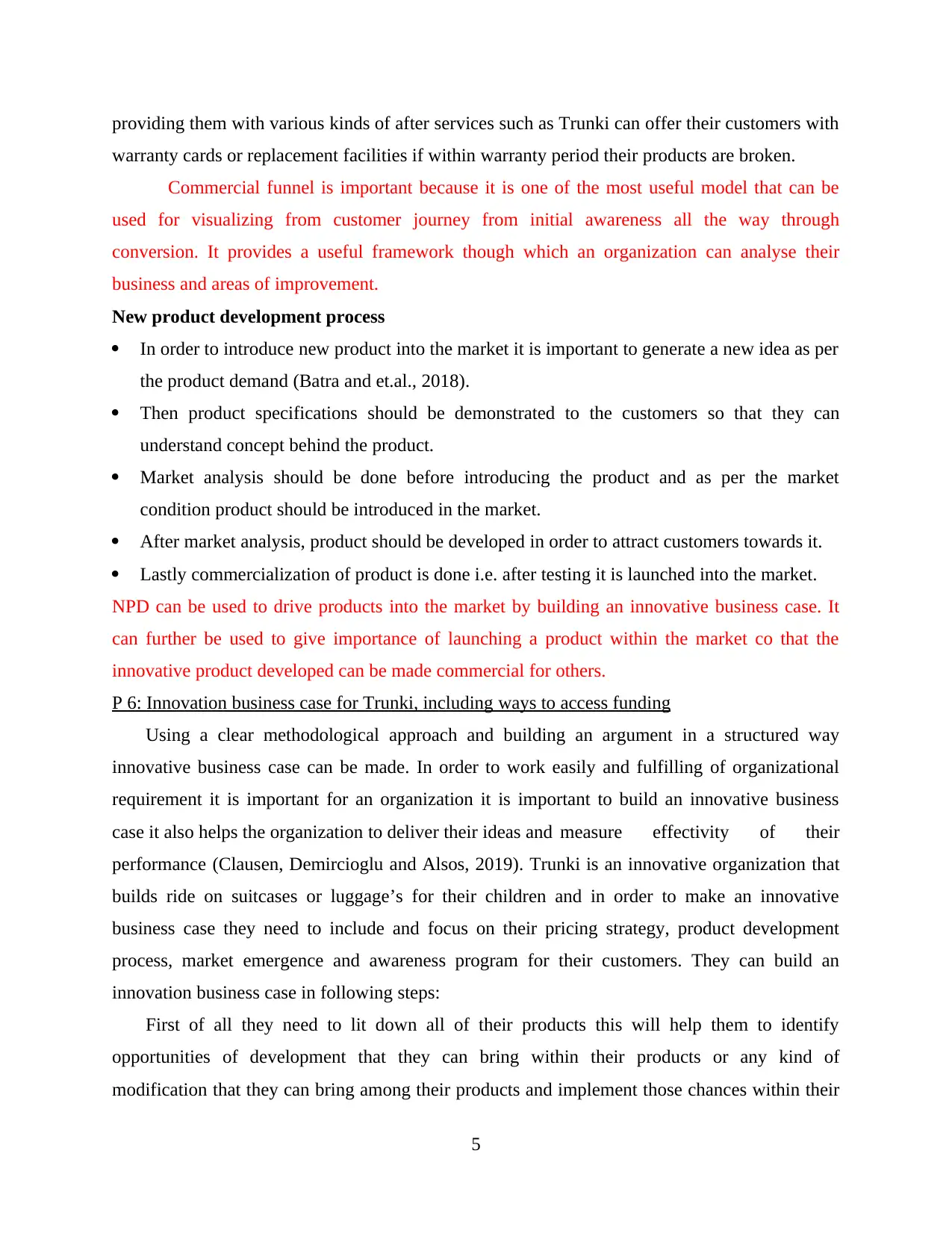
providing them with various kinds of after services such as Trunki can offer their customers with
warranty cards or replacement facilities if within warranty period their products are broken.
Commercial funnel is important because it is one of the most useful model that can be
used for visualizing from customer journey from initial awareness all the way through
conversion. It provides a useful framework though which an organization can analyse their
business and areas of improvement.
New product development process
In order to introduce new product into the market it is important to generate a new idea as per
the product demand (Batra and et.al., 2018).
Then product specifications should be demonstrated to the customers so that they can
understand concept behind the product.
Market analysis should be done before introducing the product and as per the market
condition product should be introduced in the market.
After market analysis, product should be developed in order to attract customers towards it.
Lastly commercialization of product is done i.e. after testing it is launched into the market.
NPD can be used to drive products into the market by building an innovative business case. It
can further be used to give importance of launching a product within the market co that the
innovative product developed can be made commercial for others.
P 6: Innovation business case for Trunki, including ways to access funding
Using a clear methodological approach and building an argument in a structured way
innovative business case can be made. In order to work easily and fulfilling of organizational
requirement it is important for an organization it is important to build an innovative business
case it also helps the organization to deliver their ideas and measure effectivity of their
performance (Clausen, Demircioglu and Alsos, 2019). Trunki is an innovative organization that
builds ride on suitcases or luggage’s for their children and in order to make an innovative
business case they need to include and focus on their pricing strategy, product development
process, market emergence and awareness program for their customers. They can build an
innovation business case in following steps:
First of all they need to lit down all of their products this will help them to identify
opportunities of development that they can bring within their products or any kind of
modification that they can bring among their products and implement those chances within their
5
warranty cards or replacement facilities if within warranty period their products are broken.
Commercial funnel is important because it is one of the most useful model that can be
used for visualizing from customer journey from initial awareness all the way through
conversion. It provides a useful framework though which an organization can analyse their
business and areas of improvement.
New product development process
In order to introduce new product into the market it is important to generate a new idea as per
the product demand (Batra and et.al., 2018).
Then product specifications should be demonstrated to the customers so that they can
understand concept behind the product.
Market analysis should be done before introducing the product and as per the market
condition product should be introduced in the market.
After market analysis, product should be developed in order to attract customers towards it.
Lastly commercialization of product is done i.e. after testing it is launched into the market.
NPD can be used to drive products into the market by building an innovative business case. It
can further be used to give importance of launching a product within the market co that the
innovative product developed can be made commercial for others.
P 6: Innovation business case for Trunki, including ways to access funding
Using a clear methodological approach and building an argument in a structured way
innovative business case can be made. In order to work easily and fulfilling of organizational
requirement it is important for an organization it is important to build an innovative business
case it also helps the organization to deliver their ideas and measure effectivity of their
performance (Clausen, Demircioglu and Alsos, 2019). Trunki is an innovative organization that
builds ride on suitcases or luggage’s for their children and in order to make an innovative
business case they need to include and focus on their pricing strategy, product development
process, market emergence and awareness program for their customers. They can build an
innovation business case in following steps:
First of all they need to lit down all of their products this will help them to identify
opportunities of development that they can bring within their products or any kind of
modification that they can bring among their products and implement those chances within their
5
Paraphrase This Document
Need a fresh take? Get an instant paraphrase of this document with our AI Paraphraser
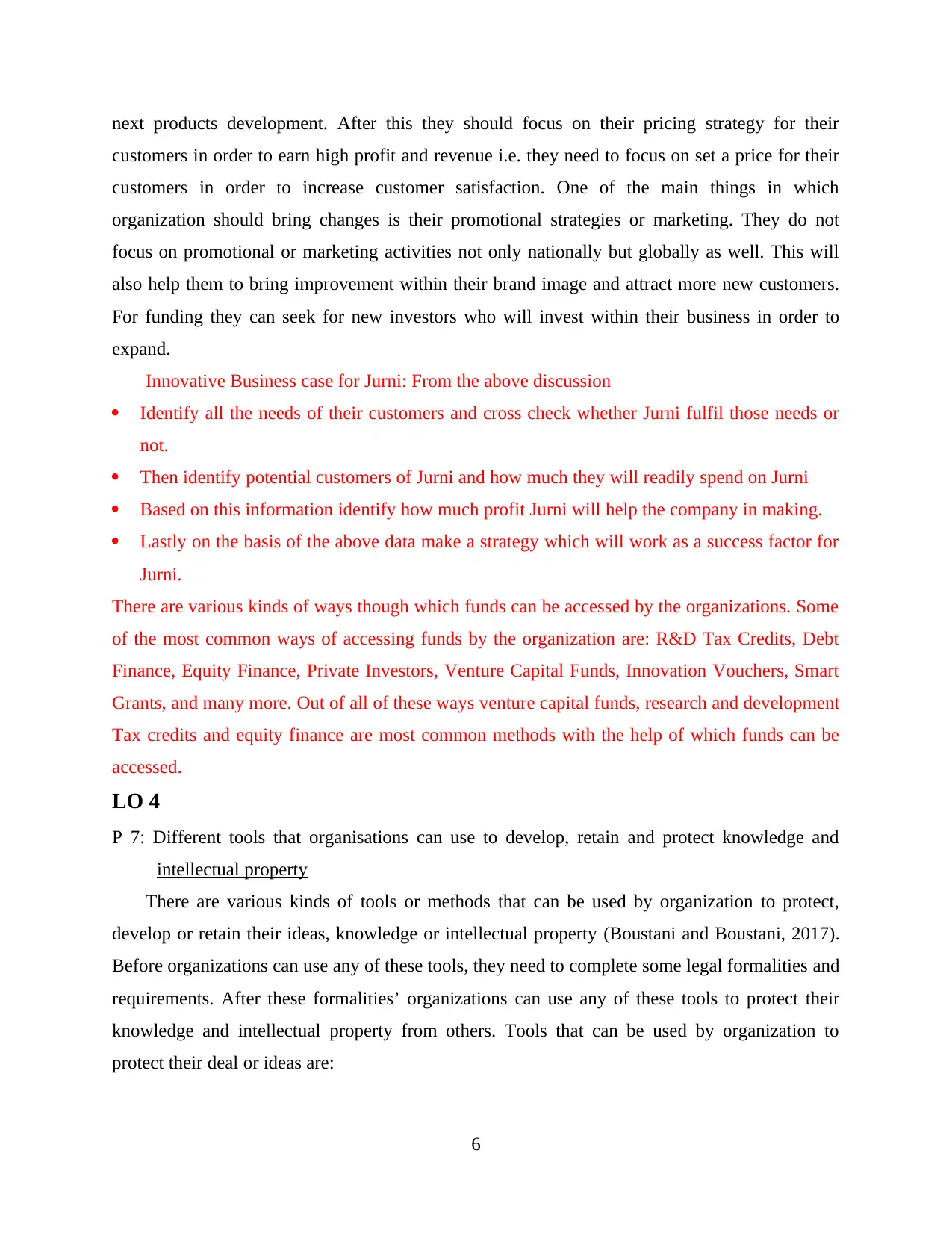
next products development. After this they should focus on their pricing strategy for their
customers in order to earn high profit and revenue i.e. they need to focus on set a price for their
customers in order to increase customer satisfaction. One of the main things in which
organization should bring changes is their promotional strategies or marketing. They do not
focus on promotional or marketing activities not only nationally but globally as well. This will
also help them to bring improvement within their brand image and attract more new customers.
For funding they can seek for new investors who will invest within their business in order to
expand.
Innovative Business case for Jurni: From the above discussion
Identify all the needs of their customers and cross check whether Jurni fulfil those needs or
not.
Then identify potential customers of Jurni and how much they will readily spend on Jurni
Based on this information identify how much profit Jurni will help the company in making.
Lastly on the basis of the above data make a strategy which will work as a success factor for
Jurni.
There are various kinds of ways though which funds can be accessed by the organizations. Some
of the most common ways of accessing funds by the organization are: R&D Tax Credits, Debt
Finance, Equity Finance, Private Investors, Venture Capital Funds, Innovation Vouchers, Smart
Grants, and many more. Out of all of these ways venture capital funds, research and development
Tax credits and equity finance are most common methods with the help of which funds can be
accessed.
LO 4
P 7: Different tools that organisations can use to develop, retain and protect knowledge and
intellectual property
There are various kinds of tools or methods that can be used by organization to protect,
develop or retain their ideas, knowledge or intellectual property (Boustani and Boustani, 2017).
Before organizations can use any of these tools, they need to complete some legal formalities and
requirements. After these formalities’ organizations can use any of these tools to protect their
knowledge and intellectual property from others. Tools that can be used by organization to
protect their deal or ideas are:
6
customers in order to earn high profit and revenue i.e. they need to focus on set a price for their
customers in order to increase customer satisfaction. One of the main things in which
organization should bring changes is their promotional strategies or marketing. They do not
focus on promotional or marketing activities not only nationally but globally as well. This will
also help them to bring improvement within their brand image and attract more new customers.
For funding they can seek for new investors who will invest within their business in order to
expand.
Innovative Business case for Jurni: From the above discussion
Identify all the needs of their customers and cross check whether Jurni fulfil those needs or
not.
Then identify potential customers of Jurni and how much they will readily spend on Jurni
Based on this information identify how much profit Jurni will help the company in making.
Lastly on the basis of the above data make a strategy which will work as a success factor for
Jurni.
There are various kinds of ways though which funds can be accessed by the organizations. Some
of the most common ways of accessing funds by the organization are: R&D Tax Credits, Debt
Finance, Equity Finance, Private Investors, Venture Capital Funds, Innovation Vouchers, Smart
Grants, and many more. Out of all of these ways venture capital funds, research and development
Tax credits and equity finance are most common methods with the help of which funds can be
accessed.
LO 4
P 7: Different tools that organisations can use to develop, retain and protect knowledge and
intellectual property
There are various kinds of tools or methods that can be used by organization to protect,
develop or retain their ideas, knowledge or intellectual property (Boustani and Boustani, 2017).
Before organizations can use any of these tools, they need to complete some legal formalities and
requirements. After these formalities’ organizations can use any of these tools to protect their
knowledge and intellectual property from others. Tools that can be used by organization to
protect their deal or ideas are:
6
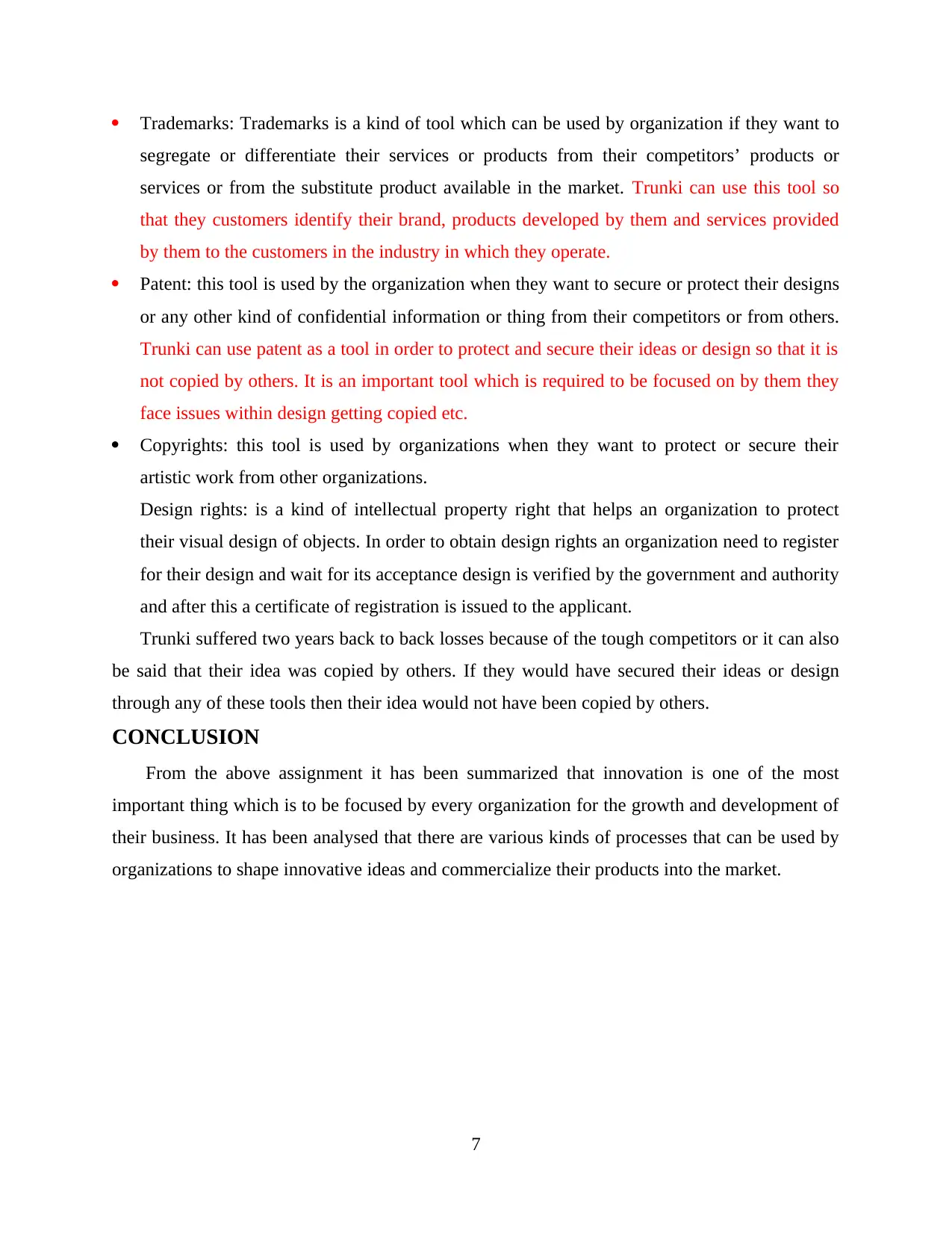
Trademarks: Trademarks is a kind of tool which can be used by organization if they want to
segregate or differentiate their services or products from their competitors’ products or
services or from the substitute product available in the market. Trunki can use this tool so
that they customers identify their brand, products developed by them and services provided
by them to the customers in the industry in which they operate.
Patent: this tool is used by the organization when they want to secure or protect their designs
or any other kind of confidential information or thing from their competitors or from others.
Trunki can use patent as a tool in order to protect and secure their ideas or design so that it is
not copied by others. It is an important tool which is required to be focused on by them they
face issues within design getting copied etc.
Copyrights: this tool is used by organizations when they want to protect or secure their
artistic work from other organizations.
Design rights: is a kind of intellectual property right that helps an organization to protect
their visual design of objects. In order to obtain design rights an organization need to register
for their design and wait for its acceptance design is verified by the government and authority
and after this a certificate of registration is issued to the applicant.
Trunki suffered two years back to back losses because of the tough competitors or it can also
be said that their idea was copied by others. If they would have secured their ideas or design
through any of these tools then their idea would not have been copied by others.
CONCLUSION
From the above assignment it has been summarized that innovation is one of the most
important thing which is to be focused by every organization for the growth and development of
their business. It has been analysed that there are various kinds of processes that can be used by
organizations to shape innovative ideas and commercialize their products into the market.
7
segregate or differentiate their services or products from their competitors’ products or
services or from the substitute product available in the market. Trunki can use this tool so
that they customers identify their brand, products developed by them and services provided
by them to the customers in the industry in which they operate.
Patent: this tool is used by the organization when they want to secure or protect their designs
or any other kind of confidential information or thing from their competitors or from others.
Trunki can use patent as a tool in order to protect and secure their ideas or design so that it is
not copied by others. It is an important tool which is required to be focused on by them they
face issues within design getting copied etc.
Copyrights: this tool is used by organizations when they want to protect or secure their
artistic work from other organizations.
Design rights: is a kind of intellectual property right that helps an organization to protect
their visual design of objects. In order to obtain design rights an organization need to register
for their design and wait for its acceptance design is verified by the government and authority
and after this a certificate of registration is issued to the applicant.
Trunki suffered two years back to back losses because of the tough competitors or it can also
be said that their idea was copied by others. If they would have secured their ideas or design
through any of these tools then their idea would not have been copied by others.
CONCLUSION
From the above assignment it has been summarized that innovation is one of the most
important thing which is to be focused by every organization for the growth and development of
their business. It has been analysed that there are various kinds of processes that can be used by
organizations to shape innovative ideas and commercialize their products into the market.
7
⊘ This is a preview!⊘
Do you want full access?
Subscribe today to unlock all pages.

Trusted by 1+ million students worldwide
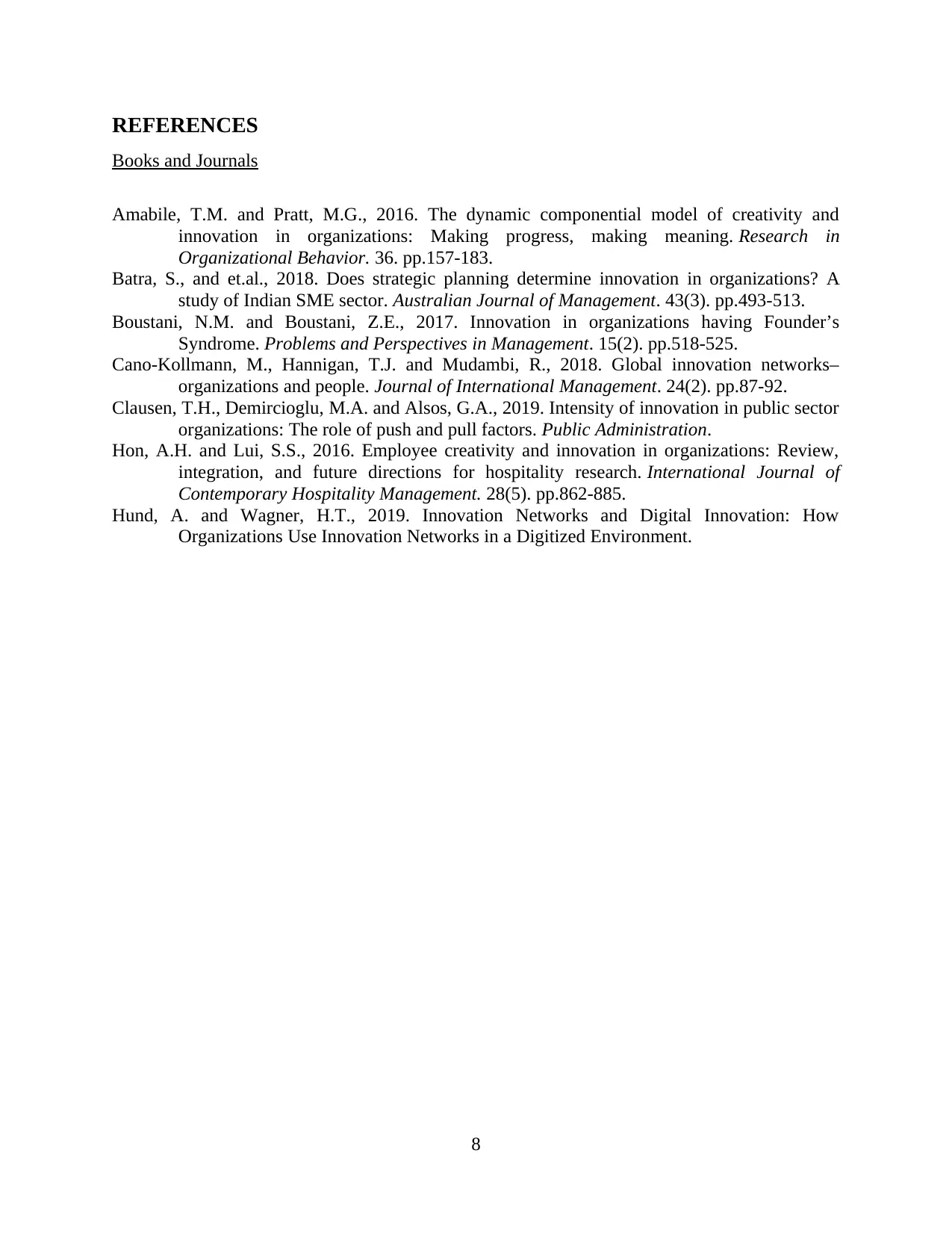
REFERENCES
Books and Journals
Amabile, T.M. and Pratt, M.G., 2016. The dynamic componential model of creativity and
innovation in organizations: Making progress, making meaning. Research in
Organizational Behavior. 36. pp.157-183.
Batra, S., and et.al., 2018. Does strategic planning determine innovation in organizations? A
study of Indian SME sector. Australian Journal of Management. 43(3). pp.493-513.
Boustani, N.M. and Boustani, Z.E., 2017. Innovation in organizations having Founder’s
Syndrome. Problems and Perspectives in Management. 15(2). pp.518-525.
Cano-Kollmann, M., Hannigan, T.J. and Mudambi, R., 2018. Global innovation networks–
organizations and people. Journal of International Management. 24(2). pp.87-92.
Clausen, T.H., Demircioglu, M.A. and Alsos, G.A., 2019. Intensity of innovation in public sector
organizations: The role of push and pull factors. Public Administration.
Hon, A.H. and Lui, S.S., 2016. Employee creativity and innovation in organizations: Review,
integration, and future directions for hospitality research. International Journal of
Contemporary Hospitality Management. 28(5). pp.862-885.
Hund, A. and Wagner, H.T., 2019. Innovation Networks and Digital Innovation: How
Organizations Use Innovation Networks in a Digitized Environment.
8
Books and Journals
Amabile, T.M. and Pratt, M.G., 2016. The dynamic componential model of creativity and
innovation in organizations: Making progress, making meaning. Research in
Organizational Behavior. 36. pp.157-183.
Batra, S., and et.al., 2018. Does strategic planning determine innovation in organizations? A
study of Indian SME sector. Australian Journal of Management. 43(3). pp.493-513.
Boustani, N.M. and Boustani, Z.E., 2017. Innovation in organizations having Founder’s
Syndrome. Problems and Perspectives in Management. 15(2). pp.518-525.
Cano-Kollmann, M., Hannigan, T.J. and Mudambi, R., 2018. Global innovation networks–
organizations and people. Journal of International Management. 24(2). pp.87-92.
Clausen, T.H., Demircioglu, M.A. and Alsos, G.A., 2019. Intensity of innovation in public sector
organizations: The role of push and pull factors. Public Administration.
Hon, A.H. and Lui, S.S., 2016. Employee creativity and innovation in organizations: Review,
integration, and future directions for hospitality research. International Journal of
Contemporary Hospitality Management. 28(5). pp.862-885.
Hund, A. and Wagner, H.T., 2019. Innovation Networks and Digital Innovation: How
Organizations Use Innovation Networks in a Digitized Environment.
8
1 out of 10
Related Documents
Your All-in-One AI-Powered Toolkit for Academic Success.
+13062052269
info@desklib.com
Available 24*7 on WhatsApp / Email
![[object Object]](/_next/static/media/star-bottom.7253800d.svg)
Unlock your academic potential
Copyright © 2020–2025 A2Z Services. All Rights Reserved. Developed and managed by ZUCOL.




![Innovation and Commercialisation Report - Unit 08: [College Name]](/_next/image/?url=https%3A%2F%2Fdesklib.com%2Fmedia%2Fimages%2Fdl%2F5be89891cd83445383609a2cae4964d9.jpg&w=256&q=75)
